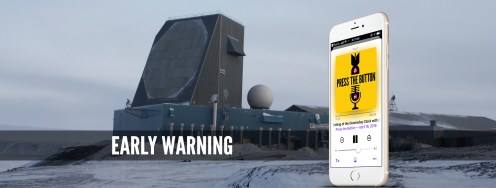House Looking to Increase Pressure on North Korea
On the radar: The Iran sanctions model; Exploding nuclear spending; Diplomacy and North Korea; Consensus-seeking; and the CIA’s missile mountaineers.
On the radar: The Iran sanctions model; Exploding nuclear spending; Diplomacy and North Korea; Consensus-seeking; and the CIA’s missile mountaineers.
April 29, 2013 | Edited by Benjamin Loehrke and Alyssa Demus
Sanctions - The House has a bipartisan bill proposing to increase sanctions on North Korea “by punishing companies, banks and governments that do prohibited business with it.” The bill is “modeled on sanctions in force against Iran...[It] does not name any particular entities but potentially could impact companies and banks in China through which the North conducts most of its business,” reports AP
--Chairman of the House Foreign Affairs Committee Ed Royce (R-CA), one of the leaders behind the new bill, “has called for tougher unilateral steps, as the U.S. government did in 2005 against a Macau-based bank because it held about $25 million in North Korean funds. That measure had a significant impact, but proved complicated to undo when nuclear negotiations with North Korea finally got back on track.” Full story here. http://wapo.st/10nvCfk
Welcome to Early Warning - Subscribe to our morning email or follow us on twitter.
--Have a tip or feedback for the editor? Email earlywarning@ploughshares.org earlywarning@ploughshares.org. Want to support this work? Click here.
Tweet - @Princeton: University and @PPPLab scientists are working together to develop a better system to verify nuclear warheads. http://t.co/Z9RMesm7yf
Flush budgets - The National Nuclear Security Administration (NNSA) is looking for a 17% increase to its nuclear weapons budget - rising to $7.87 billion next year. “In a time when the U.S. nuclear arsenal is shrinking and the Obama administration seeks further mutual arms reductions with Russia, this overreach by the National Nuclear Security Administration is hard to understand,” write Kevin Martin and Jay Coghlan in The Hill. The authors suggest that Congress scrutinize NNSA’s budget requests and pair back failing programs. Full post here. http://bit.ly/15UpzaB
Hot seat - “The cost overruns, safety and security incidents, and failed projects at NNSA must come to a stop,” said Sen. Tom Udall (D-NM) last week in a hearing on NNSA’s budget request.
--“It is project after project, and it is right in your face and you can’t ignore it because the dollars are so big,” said Sen. Dianne Feinstein (D-CA) in the hearing. Michael Coleman of the Albuquerque Journal gives a state of play on NNSA’s budget in his article “Nuclear Spending on Hot Seat.” http://bit.ly/18eIUzG
Audio - “What Nuclear Weapons Can the United States Afford?” Panel discussion with Walter Pincus, Barry Blechman, Eric Edleman, Garrett Harencak and David Mosher. http://owl.li/kwX9z
Prospects with Pyongyang - After weeks of North Korean provocations, many are pushing for a diplomatic solution to resolve long-standing tensions with Pyongyang over its nuclear program. “A new diplomatic offensive, which might open an avenue to peaceful resolution of the current crisis, would demonstrate that the [US] understands that exercising leadership means more than just flexing military muscle,” Joel Wit said in an interview with The Washington Post.
-- While diplomacy is preferable, obstacles to dialogue persist. The North’s preconditions are steep, its recent fiery rhetoric has left a poor taste in American minds “which will be hard to undo through any exchanges or negotiations any time soon,” and the regime continues to blame the US for its every misfortune from poverty to power outages. So, the question remains: “can we talk?” asks The Washington Post. Full article here. http://owl.li/kwFVO
Tweet - @Reuters: North Korea holds back seven South Koreans at industrial zone. http://owl.li/kwCXl
Fuzzy red lines - “Israel risks a loss of credibility over both its ‘red line’ for Iran's nuclear program and its threat of military action, and its room for unilateral maneuver is shrinking,” write Crispian Balmer and Dan WIlliams for Reuters. Full story here. http://owl.li/kwMMv
Tweet - @tparsi: Iran Eager to Restart Nuclear Talks. http://owl.li/kwC59
GAO Report - “MISSILE DEFENSE: Opportunity to Refocus on Strengthening Acquisition Management” from the Government Accountability Office. April 2013. (pdf) http://1.usa.gov/ZfH7Xe
Report - “Forging a Consensus for a Sustainable U.S. Nuclear Posture: A Report of the CSIS Nuclear Consensus Working Group.” Consensus from Barry Blechman, Linton Brooks, Robert Degrasse, Robert Joseph, Frank Klotz, Frank Miller and George Perkovich. Study chaired by Clark Murdock. Authors: Stephanie Spies and John Warden. (pdf) http://bit.ly/Y8FsWa
Events:
--"After North Korea’s Third Nuclear Test: Challenges for the U.S. and Its Regional Allies." Ralph Cossa, Center for Strategic and International Studies. May 1 12:30-2:00pm @ National Defense University, Lincoln Hall, Room 1105.
--"The Nuclear Security Summit in 2014: Challenges and Opportunities." Piet de Klerk, Dutch Foreign Affairs Ministry. May 2 9:00-10:30am @ Carnegie. Details here. http://owl.li/kwTqp
--"Reducing Global Weapons Dangers: Bolstering the NPT and Building the New ATT Regime," (Part of the Arms Control Association annual meeting). Ellen Tauscher and six other speakers. May 6 9:00-1:30am @ Carnegie, Root Room. Details Here. http://owl.li/kwU8t
--Senate floor vote on the nomination of Ernie Moniz to be Energy Secretary. Week of May 6. Broadcast and webcast on C-SPAN2 here. http://owl.li/kwUJ7
Dessert:
Trinity tourism - The Trinity Site, location of the world’s first nuclear test, is open to the public for two days a year. The site, open earlier this month, elicits varied responses from its many visitors. For some like a “79-year-old Texan, it conjures up memories of sitting next to a radio as the joyous news arrived - World War II was over.”
--Others like Takashi Arai, a Japanese photographer, are “taken aback...For the Japanese, the Trinity Site remains an ominous place - a tragedy.” Cindy Carcamo has the story for The Los Angeles Times. http://owl.li/kwJy1
Before spies had satellites - In the mid-1960s, the CIA sent a group of mountaineers into the Himalayas to put a plutonium-powered missile monitor on a 25,000-foot mountain in India to monitor China’s long-range missile development. The expedition abandoned its summit attempt due to bad weather, stashing the equipment in a crevice to return next spring. The equipment - and its plutonium - was lost in a landslide and never recovered.
--A later mission eventually got a sensor on another Indian mountain top. But it’s a good reminder of the lengths the U.S. went to for intelligence gathering before we had surveillance satellites. Robert Beckhusen of Danger Room has the story. http://bit.ly/ZRxlh4


